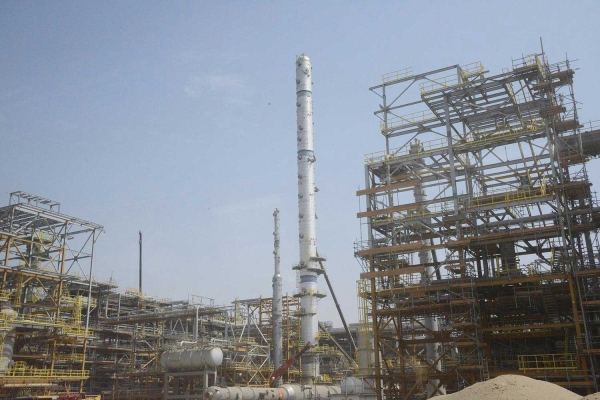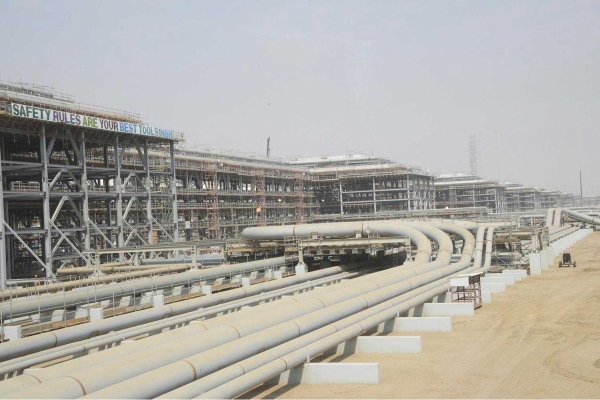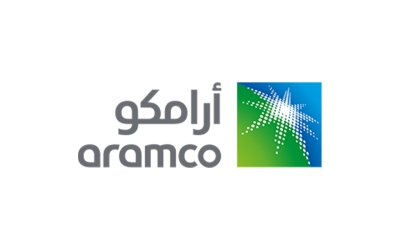

Jazan Refinery is one of Saudi Aramco's projects in the refining and petrochemicals sector. It is located in Jazan City for Primary and Downstream Industries.
Integration of Jazan Refinery works
The refinery is located in Jazan City for Primary and Downstream Industries on the coast of Baysh, overlooking the Red Sea in the southwest of the Kingdom of Saudi Arabia. It covers an area of twelve km² and is wholly owned by Saudi Aramco. The refinery complex has a refining capacity of four hundred thousand barrels per day, alongside al-Farda, and includes a gas plant that operates on an integrated cycle.
This complete conversion refinery is a significant development for Jazan Province, resulting from an investment of USD21 billion. It is designed to produce a wide range of products at full production capacity, including gasoline, ultra-light sulfur diesel, benzene, and paraxylene. Additionally, it provides feedstock for the integrated gasification combined-cycle (IGCC) plant, which generates power and industrial gases.
The investment role of Jazan Refinery
The establishment of Jazan City for Primary and Downstream Industries, in which Saudi Aramco cooperates with the Royal Commission for Jubail and Yanbu, supports the investment and development goals in Jazan Province. It is considered an important hub for economic growth in the region and serves as a major future drive for foreign direct investment in the Kingdom.
With the implementation of the expansion strategy in the refining, processing, and marketing sector at Saudi Aramco, this refinery is the fifth wholly owned by Saudi Aramco within the Kingdom. It works to meet the country’s demand for refined products and electrical energy, thereby supporting economic growth.
Complex facilities
The projects being implemented in the refinery complex are integrated, featuring numerous vital installations and facilities, including a large power station utilizing integrated combined cycle gasification technology. This power station can produce 3.8 GW of electricity and continues production even when the energy needs of the station and local industries are met, thereby supplying millions of homes in the region. Additionally, the complex includes a subsidiary waste unloading facility with a capacity of 103,000 barrels per day, capable of producing 3.85 GW of energy, hydrogen, and steam. The complex also houses other facilities supporting the refinery and Jazan City for Primary and Downstream Industries.
Many essential facilities have been established as an inevitable result of the refinery's business growth. The expansion includes a marine terminal capable of accommodating large crude oil tankers for the refinery supply operations and export of petroleum products inside and outside the Kingdom, in addition to the 1.7 km Baysh Corniche that accommodates fishermen's harbor, green spaces, and various service and entertainment centers.
Besides the refinery complex, Saudi Aramco is implementing a number of basic and ancillary projects comprising the development of the Jazan City for Primary and Downstream Industries’ infrastructure, an integrated liquid-to-gas plant, construction of a power plant, a commercial port, and a desalination plant, as well as the construction of roads, water, sewage, and power networks, so that the sum of these projects provides a solid foundation for investments in heavy and secondary industries, petrochemicals, mineral industries, and other transformational investments that benefit from the mineral and agricultural wealth of the region.
Sustainability
Saudi Aramco facilities operate according to the principle of sustainability, which formed the basis for planning all aspects of business at the Jazan Refinery. The ambition was to enhance efficiency and reduce carbon emissions, including through the soot ash removal unit, which reduces dust emissions into the atmosphere. The dry ash collected during this process is usually disposed of in a landfill at other facilities. However, at the Jazan complex, the dry ash is passed to a specialized operator to extract rare metals such as nickel and vanadium contained in the ash.
The complex was designed with a futuristic vision to extract, from the dry ash in Jazan each year, more than 7,200 t of nickel used in minting coins, batteries, and stainless steel, and vanadium, which is mixed with steel to manufacture heavy-duty equipment, jet engines, automobile parts, and machinery components.
Related quizzes


